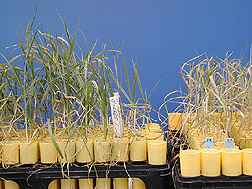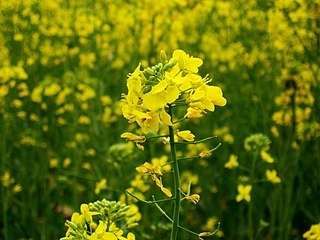Related Research Articles

Rice is a cereal grain and in its domesticated form is the staple food of over half of the world's population, particularly in Asia and Africa. Rice is the seed of the grass species Oryza sativa —or, much less commonly, O. glaberrima. Asian rice was domesticated in China some 13,500 to 8,200 years ago; African rice was domesticated in Africa about 3,000 years ago. Rice has become commonplace in many cultures worldwide; in 2021, 787 million tons were produced, placing it fourth after sugarcane, maize, and wheat. Only some 8% of rice is traded internationally. China, India, and Indonesia are the largest consumers of rice. A substantial amount of the rice produced in developing nations is lost after harvest through factors such as poor transport and storage. Rice yields can be reduced by pests including insects, rodents, and birds, as well as by weeds, and by diseases such as rice blast. Traditional rice polycultures such as rice-duck farming, and modern integrated pest management seek to control damage from pests in a sustainable way.

The Green Revolution, or the Third Agricultural Revolution, was a period of technology transfer initiatives that saw greatly increased crop yields. These changes in agriculture began in developed countries in the early 20th century and spread globally until the late 1980s. In the late 1960s, farmers began incorporating new technologies such as high-yielding varieties of cereals, particularly dwarf wheat and rice, and the widespread use of chemical fertilizers, pesticides, and controlled irrigation.
Heterosis, hybrid vigor, or outbreeding enhancement is the improved or increased function of any biological quality in a hybrid offspring. An offspring is heterotic if its traits are enhanced as a result of mixing the genetic contributions of its parents. The heterotic offspring often has traits that are more than the simple addition of the parents' traits, and can be explained by Mendelian or non-Mendelian inheritance. Typical heterotic/hybrid traits of interest in agriculture are higher yield, quicker maturity, stability, drought tolerance etc.

The International Rice Research Institute (IRRI) is an international agricultural research and training organization with its headquarters in Los Baños, Laguna, in the Philippines, and offices in seventeen countries. IRRI is known for its work in developing rice varieties that contributed to the Green Revolution in the 1960s which preempted the famine in Asia.

New Rice for Africa (NERICA) is a cultivar group of interspecific hybrid rice developed by the Africa Rice Center (AfricaRice) to improve the yield of African rice cultivars. Although 240 million people in West Africa rely on rice as the primary source of food energy and protein in their diet, the majority of this rice is imported. Self-sufficiency in rice production would improve food security and aid economic development in West Africa.

Yuan Longping was a Chinese agronomist and inventor. He was a member of the Chinese Academy of Engineering known for developing the first hybrid rice varieties in the 1970s, part of the Green Revolution in agriculture. For his contributions, Yuan is known as the "Father of Hybrid Rice".
Semi-dwarf IR36 is a hybrid rice variety developed by Gurdev Khush.

Intensive crop farming is a modern industrialized form of crop farming. Intensive crop farming's methods include innovation in agricultural machinery, farming methods, genetic engineering technology, techniques for achieving economies of scale in production, the creation of new markets for consumption, patent protection of genetic information, and global trade. These methods are widespread in developed nations.

Gibberella fujikuroi is a fungal plant pathogen. It causes bakanae disease in rice seedlings.
Upland rice is rice grown in drier environments. The term describe varieties of rice developed for rain-fed or less-intensely irrigated soil instead of flooded rice paddy fields, or it may describe rice grown outside of paddies.

Rice production in China is the amount of rice planted, grown, and harvested for consumption in the mainland of China.

Perennial rice are varieties of long-lived rice that are capable of regrowing season after season without reseeding; they are being developed by plant geneticists at several institutions. Although these varieties are genetically distinct and will be adapted for different climates and cropping systems, their lifespan is so different from other kinds of rice that they are collectively called perennial rice. Perennial rice—like many other perennial plants—can spread by horizontal stems below or just above the surface of the soil but they also reproduce sexually by producing flowers, pollen and seeds. As with any other grain crop, it is the seeds that are harvested and eaten by humans.

Genetically modified rice are rice strains that have been genetically modified. Rice plants have been modified to increase micronutrients such as vitamin A, accelerate photosynthesis, tolerate herbicides, resist pests, increase grain size, generate nutrients, flavors or produce human proteins.

Plant breeding is the science of changing the traits of plants in order to produce desired characteristics. It has been used to improve the quality of nutrition in products for humans and animals. The goals of plant breeding are to produce crop varieties that boast unique and superior traits for a variety of applications. The most frequently addressed agricultural traits are those related to biotic and abiotic stress tolerance, grain or biomass yield, end-use quality characteristics such as taste or the concentrations of specific biological molecules and ease of processing.
Plant breeding started with sedentary agriculture, particularly the domestication of the first agricultural plants, a practice which is estimated to date back 9,000 to 11,000 years. Initially, early human farmers selected food plants with particular desirable characteristics and used these as a seed source for subsequent generations, resulting in an accumulation of characteristics over time. In time however, experiments began with deliberate hybridization, the science and understanding of which was greatly enhanced by the work of Gregor Mendel. Mendel's work ultimately led to the new science of genetics. Modern plant breeding is applied genetics, but its scientific basis is broader, covering molecular biology, cytology, systematics, physiology, pathology, entomology, chemistry, and statistics (biometrics). It has also developed its own technology. Plant breeding efforts are divided into a number of different historical landmarks.
Ebrahimali Abubacker Siddiq is an Indian agricultural scientist, whose research in genetics and plant breeding is reported to have assisted in the development of various high-yielding rice varieties such as dwarf basmati and hybrid rice. The government of India honoured Siddiq in 2011 with the fourth-highest civilian award of Padma Shri.

Dilbagh Singh Athwal was an Indian-American geneticist, plant breeder and agriculturist, known to have conducted pioneering research in plant breeding. He was a professor and the Head of the Department of Plant Breeding at Punjab Agricultural University and an associate of Norman Borlaug, a renowned biologist and Nobel Laureate, with whom he has collaborated for the introduction of high-yielding dwarf varieties of wheat.
Li Zhengyou was a Chinese agronomist and politician. A professor of Yunnan Agricultural University, he created the Dian-type hybrid rice and was called the "father of high-altitude hybrid rice". He served as Vice-Governor of Yunnan Province from 1983 to 1988, and Chairman of the Yunnan Science and Technology Society.

Dhara Mustard Hybrid-11, otherwise known as DMH - 11, is a genetically modified hybrid variety of the mustard species Brassica juncea. It was developed by Professor Deepak Pental from the University of Delhi, with the aim of reducing India's demand for edible oil imports. DMH - 11 was created through transgenic technology, primarily involving the Bar, Barnase and Barstar gene system. The Barnase gene confers male sterility, while the Barstar gene restores DMH - 11's ability to produce fertile seeds. The insertion of the third gene Bar, enables DMH - 11 to produce phosphinothricin-N- acetyl-transferase, the enzyme responsible for Glufosinate resistance. This hybrid mustard variety has come under intense public scrutiny, mainly due to concerns regarding DMH - 11's potential to adversely affect the environment as well as consumer health. DMH - 11 was found not to pose any food allergy risks, and has demonstrated increased yields over existing mustard varieties. Conflicting details and results regarding the field trials and safety evaluations conducted on DMH - 11 have delayed its approval for commercial cropping.

Rice production in Myanmar accounts for approximately 43% of total agricultural production in the country, making it the seventh largest producer of rice in the world. Out of 67.6 million hectares of land, 12.8 million are used for cultivation. In 2019 alone, Myanmar accounted for 13,300 million metric tons of milled rice production.
References
- ↑ IRRI Hybrid Rice, IRRI.org
- ↑ About hybrid rice, from the International Rice Research Institute.
- ↑ Jenkin W. Jones, 1926. Hybrid vigor in rice. J. Am. Soc. Agron. 18, 423–428.
- ↑ FAO.org (2004). "Hybrid Rice for Food Security" (PDF). Fact Sheet. Food and Agriculture Organization of the United Nations. Retrieved 2009-10-19.
- ↑ The man who puts an end to hunger: Yuan Longping, "Father of Hybrid Rice". Beijing: Foreign Languages Press. 2007. ISBN 9787119051093.
- ↑ Hybridizing the world - The father of hybrid rice Archived 2012-03-31 at the Wayback Machine , Rice Today (Oct-Dec, 2010)
- ↑ Ren, Weidong (2018-04-11). "追忆高原杂交稻之父李铮友". Guangming Daily. Retrieved 2018-04-16.
- ↑ "李铮友同志逝世". People's Daily. 2018-04-13. Retrieved 2018-04-16.
- ↑ Oudhia P, Pandey N, Ganguli RN & Tripathi RS (1999) Gall midge (Orseolia oryzae) infestation in hybrid rice as affected by agronomical practices. Insect Environment 4: 123–124.
- ↑ Hybrid rice history, International Rice Research Institute.
- ↑ IRRI Technical Bulletin No.14 - Hybrid rice adoption in India: farm level impacts and challenges
- ↑ "Seedlings of evil growing in Myanmar". farmlandgrab.org. Retrieved 2024-06-27.
- ↑ "Burma: Seedlings of evil". grain.org (in Spanish). Retrieved 2024-06-27.
- ↑ Our science: Hybrid rice, International Rice Research Institute.
- ↑ D'Angelo, J. et al. 2023. Mitigating risks of hybrid rice use in terrace agriculture. Geography and Sustainability, Volume 4 Issue 1, Pages 1-5. https://doi.org/10.1016/j.geosus.2022.11.002
- ↑ Adam Barclay, A Hybrid History,Rice Today, October–December 2007
- ↑ Checco, J. et al 2023. Adoption of improved rice varieties in the Global South: A Review. Rice Science. Volume 30, Issue 3 p. 186-206 https://doi.org/10.1016/j.rsci.2023.03.004
- 1 2 3 Wto. “Hybrid Rice in Asia: An Unfolding Threat.” GRAIN, https://www.grain.org/article/entries/34-hybrid-rice-in-asia-an-unfolding-threat.
- 1 2 Progress and Issues in Development and Use of Hybrid Rice in the Tropics - S.S. Virmani, http://www.fao.org/3/Y4751E/y4751e0g.htm.
- ↑ J. Li, Y. Xin, L. Yuan Hybrid Rice Technology Development: Ensuring China's Food Security International Food Policy Research Institute (IFPRI) (2009) IFPRI Discussion Paper 00918
- 1 2 3 D'Angelo, J. et al 2023. Mitigating risks of hybrid rice use in terrace agriculture. Geography and Sustainability. Volume 4, Issue 1 p. 1-5 https://doi.org/10.1016/j.geosus.2022.11.002
